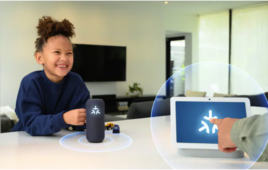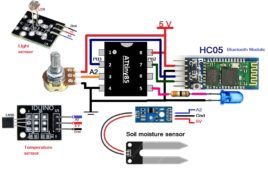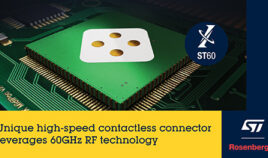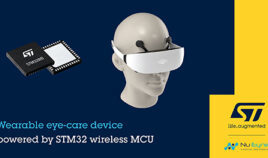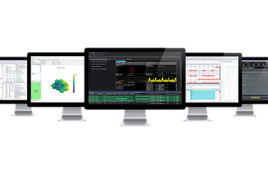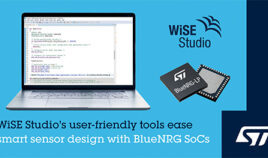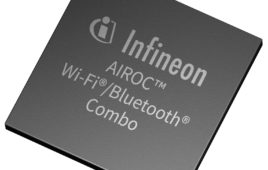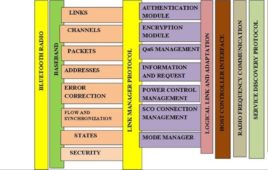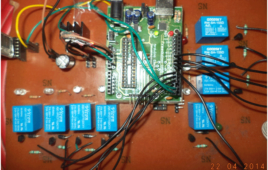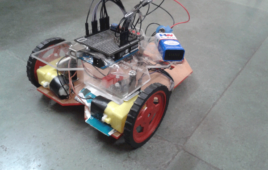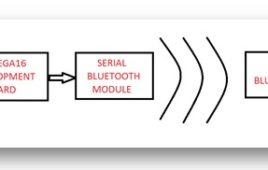NXP Semiconductors has announced the IW612, the industry’s first secure tri-radio device to support the Wi-Fi 6, Bluetooth 5.2, and 802.15.4 protocols. Part of NXP’s new family of tri-radio products, the new device enables seamless, secure connectivity for smart home, automotive, and industrial use-cases. It also supports the new groundbreaking Matter connectivity protocol. The IW612…
Infineon expands wireless portfolio to support Matter with multi-protocol solutions
Infineon Technologies has announced the launch of the new AIROC Bluetooth LE and 802.15.4 family to help companies quickly bring low-power, high-performing Matter products to market. The powerful combination of complementary Bluetooth LE and 802.15.4 protocols enhances the performance of smart home products with seamless interoperability, enabling end-to-end encrypted communication between individual devices in a Matter…
Tutorial 9: Device control using smart phone’s Bluetooth and ATtiny85
In this tutorial series, we have learned about interfacing potentiometer to get analog input, interfacing of RGB LED by generating PWM output, DC Motor speed control using PWM output, and some other things. This tutorial explains the serial communication of ATtiny85 with Bluetooth module HC05. ATtiny85 does not have built-in UART or USART with Rx…
Tutorial 10: Wireless sensor data transmitter using Bluetooth and ATtiny85
In the previous tutorial, we have learned how ATtiny85 serially communicates with Bluetooth module HC05 and send/receive commands from smartphone Bluetooth This tutorial also involves the role Bluetooth module HC05. But instead of receiving commands from a smartphone, it sends sensor data values to the smartphone. The sensor is connected to an analog input pin…
Renesas developing wireless MCUs for new Bluetooth 5.3 low-energy specification
Renesas Electronics Corporation, a supplier of advanced semiconductor solutions, announced that it’s developing new microcontrollers (MCUs) that will support the recently released Bluetooth 5.3 Low Energy (LE) Specification. The new devices will be part of the Renesas Advanced (RA) Family of 32-bit Arm Cortex-M microcontrollers, joining the RA4W1 Bluetooth 5.0 LE device introduced last year.…
Rosenberger and STMicroelectronics develop high-speed contactless connector
STMicroelectronics, a global semiconductor provider, and Rosenberger, a manufacturer of impedance-controlled and optical connectivity solutions, announced their collaboration on a contactless connector for ultra-reliable, short-range, point-to-point full-duplex data exchanges in industrial and medical applications . Rosenberger’s innovative contactless connector, the RoProxCon, leverages ST’s 60GHz RF transceiver, the ST60A2, to deliver high-speed data transmission while providing immunity…
STMicroelectronics and Nu Eyne launch smart, BLU eye-therapy device
STMicroelectronics, a global semiconductor provider, and Nu Eyne, Korea’s innovative medical device manufacturer, have jointly announced a Nu Eyne wearable therapy device for eye care, powered by an STM32WB55 dual-core Bluetooth LE (BLE) microcontroller (MCU). Nu Eyne’s recently launched CELLENA wearable device using electric current and light emitted to the eyes and associated nerves to…
Dialog provides wearables solution for OceanMedallion cruise experience
Dialog Semiconductor plc, a provider of battery and power management, Wi-Fi, Bluetooth LE, and edge-computing solutions, has announced a new partnership with Carnival Corporation. The goal is to integrate Dialog’s Wireless Ranging (WiRa) technology into Carnival’s OceanMedallion wearable devices for proximity-based locationing to ensure passenger safety and offer enhanced cruise services. Originally unveiled in 2017,…
DEKRA selects Keysight’s test solutions to verify 5G devices
Keysight Technologies, Inc., a technology company that delivers advanced design and validation solutions, announced that DEKRA, a global test organization, has selected Keysight’s 5G and internet of things (IoT) test solutions to expand 5G new radio (NR), Wi-Fi 6, and Bluetooth 5 device regulatory compliance services. Radio-frequency (RF) regulatory testing, mandated by country-specific organizations, ensure…
STMicroelectronics advances tools and connected-sensor design of its WiSE Studio
STMicroelectronics’ WiSE Studio — a free-of-charge Integrated Development Environment (IDE) dedicated to the BlueNRG system-on-chip (SoC) product family — is accelerating the design of smart, connected devices that leverage the latest Bluetooth technology. Featuring a user-friendly and customizable development environment with an extensive list of ready-to-build examples, the new IDE helps both expert and inexperienced users jump-start…
STMicroelectronics and Lierda partner to develop low-power Bluetooth module
STMicroelectronics, a global semiconductor provider, has launched a new low-power Bluetooth module from Lierda Science & Technology Group — a high-tech enterprise that provides IoT system and smart product solutions in China, uses an ST STM32WB55 Bluetooth LE (BLE) microcontroller (MCU). With its stamp-type format, Lierda’s LSD1BT-STWB5500 module is highly integrated yet resistant to interference.…
Infineon’s WiFi and Bluetooth chip gives new satnav high-powered connectivity
TomTom GO Discover, developed by TomTom, the location technology company, is one of the quickest and most powerful satnavs on the market today. The satnav with its 5, 6, and 7-inch display leverages Infineon Technologies‘ AIROC CYW43455 Wi-Fi and Bluetooth combo chip. The AIROC wireless solution combines Wi-Fi 5 (802.11 ac) and Bluetooth 5.0 on…
Bluetooth Protocol (Part 2): Types, Data Exchange, Security
Bluetooth is defined as layered protocol architecture because each layer supports the layer above and below it. The complete protocol stack consists[[wysiwyg_imageupload::]] of both Bluetooth specific protocols which are clearly defined or developed for Bluetooth like LMP and non-Bluetooth specific that were designed to enable the re-use of existing protocols for various functions. Non-specific protocols can be used with many other platforms like WAP, UDP AND OBEX.
Home appliance control using Android phone
With increasing technology, Automation has become a need whether it is home, office or some other place. At home we come across many appliances be it Fan, AC, TV, Lights, etc. What if you could operate all of them with the Android Phone you’re holding in your Hand..!!This Project aims to incorporate android phone control over electrical appliances. We use Bluetooth communication between Android phone and a Receiver (control unit) that is connected to the appliances.
Arduino Time-and-Sensor-Based Android Music Player
Imagine your music player that play for you, a player that sense the ambient LIGHT, TEMPERATURE and TIME that affects the mood of a person, and pick a song categorize as MOODs. Because I don’t have a sensor that can translate human emotion or thinking to numerical data, I assume that an environment surrounding humans can affect our emotion and which is readable as an analog data using sensors, and because time can easily affect the environment basic traits like light intensity and temperature, I found it as a good solutions for this project. The sensors I used are not enough to consider the exact environment situation; we can still add humidity and sound.
Android Phone Controlled Bluetooth Motion Vehicle
I had been working on a project to make a bluetooth controlled car which is being operated from an Android phone.The basic objective of this project is to make a gaming vehicle which would be controlled by tilting the mobile phone such that the user controls its acceleration as well as directions.The motivation behind my project came basically from the inquisition of Controlling cars using accelerometer in mobile games and PC games.Also we wanted to make such a device which could go into the areas where humans cannot go.Also on seeing many cars used by snake catchers to get the look inside of the snake holesI thought this would be a great idea as the remotes use cell batteries which are not available always but one carry his mobile everywhere.
Wireless Temperature Monitoring System Using Bluetooth
Monitoring temperature of a particular place directly is difficult and sometimes impossible (ex: places where humans cannot be). So there is a necessity for wireless monitoring system which enables the user to track the temperature from a remote location. In this article we’ll learn how to build a wireless temperature indicator which sends the temperature value to a PC/Laptop through Bluetooth. The Temperature sensor LM35 produces an output voltage which is directly proportional to its surrounding temperature. For every 1°C of rise/fall in temperature, the output voltage of the sensor varies by 10mV. The output of this sensor is analog in nature which needs to be converted into a digital value using an Analog to Digital Converter (ADC) so it is fed into 37th pin of PORT A of the ATmega16 microcontroller. ATmega16 consists of 8 channels ADC (PA0-PA7) with a maximum resolution of 10 bits.
Wireless PC Controlled Robot Using Bluetooth
In the previous tutorial I have explained how to setup a basic serial connection between an Atmega16 controller Board and a computer/laptop. In this article we’ll learn how to control a robot using the computer/laptop wirelessly through Bluetooth. Let us start with the hardware assembly part first. It should be simple since we are using a ready-made chassis. Start by attaching the motors and castor wheel to the chassis. The components needed for the project are : Atmega16 development board with 16MHz crystal, Serial Bluetooth Module(AUBTM/HC-05/HC-04/BLUSMIRF), PC/Laptop running Windows XP/7/8, USB Bluetooth(Not required if you laptop/PC has inbuilt hardware), Motor Driver L293D, 2 X 12V 100RPM Geared DC motors, 2 X Wheels, Chassis, Castor wheel, Female jumper wires. Keep on reading to find out how the robot is constructed and what coding does it use to operate.
Interfacing Serial Bluetooth Modem with Computer using ATmega16- (Part 41/46)
This project would give you a general idea about how to setup and interface any Bluetooth modem with your computer. There are many types of Bluetooth modems available in market, which vary in quality, cost, range, etc. Some of the well known Serial Bluetooth modems are AUBTM, BLUESMIRF, RN-41, HC-05 and HC-04.I would be using the last one i.e. the cheap Chinese Bluetooth module. It has limited functions and it can only work in slave mode. (Remember: Two slave modules cannot directly communicate to each other so be careful when you buy them.) The top range modules have a facility to work in both MASTER and SLAVE modes. It is Class 3 module so it range is very low. (Class 2 has a range of 10 meters and Class 1 has a range of 100 meters.)
Difference between Bluetooth and Zigbee Technologies
Bluetooth protocol is not much encouraged for long duration applications due to power consumption limitations. Hence, for small gadgets which run on battery or limited power source, a new wireless data transfer protocol was needed which could manage working with low power consumption. To fulfill these requirements, a protocol named Zigbee was announced just at…

